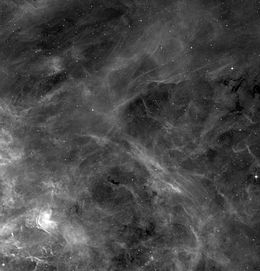| Observation data Epoch J2000 Equinox J2000 | |
|---|---|
| Constellation | Dorado |
| Right ascension | 05h 37m 34.461s[1] |
| Declination | −69° 01′ 10.20″[1] |
| Apparent magnitude (V) | 13.76[2] |
| Characteristics | |
| Evolutionary stage | Main sequence[3] |
| Spectral type | O2V-III(n)((f*))[3] |
| U−B color index | −1.02[4] |
| B−V color index | −0.13[4] |
| Astrometry | |
| Proper motion (μ) | RA: 2.3[1] mas/yr Dec.: 3.1[1] mas/yr |
| Distance | 164,000 ly (50,000[5] pc) |
| Absolute magnitude (MV) | −5.7[3] |
| Details[6] | |
| Mass | 97.6 M☉ |
| Radius | 13.9 R☉ |
| Luminosity | 1,175,000 L☉ |
| Surface gravity (log g) | 4.02 cgs |
| Temperature | 54,000 K |
| Rotational velocity (v sin i) | 185 km/s |
| Age | 0.4+0.8 −0.4 Myr |
| Other designations | |
| Database references | |
| SIMBAD | data |
BI 253 is an O2V star in the Large Magellanic Cloud and is a primary standard of the O2 type. It is one of the hottest main-sequence stars known and one of the most-massive and most-luminous stars known.
- ^ a b c d Zacharias, N.; Urban, S. E.; Zacharias, M. I.; Wycoff, G. L.; Hall, D. M.; Germain, M. E.; Holdenried, E. R.; Winter, L. (2003). "VizieR Online Data Catalog: The Second U.S. Naval Observatory CCD Astrograph Catalog (UCAC2)". CDS/ADC Collection of Electronic Catalogues. 1289. Bibcode:2003yCat.1289....0Z.
- ^ Rivero González, J. G.; Puls, J.; Najarro, F.; Brott, I. (2012). "Nitrogen line spectroscopy of O-stars. II. Surface nitrogen abundances for O-stars in the Large Magellanic Cloud". Astronomy & Astrophysics. 537: A79. arXiv:1110.5148. Bibcode:2012A&A...537A..79R. doi:10.1051/0004-6361/201117790. S2CID 119110554.
- ^ a b c Bestenlehner, J. M.; Gräfener, G.; Vink, J. S.; Najarro, F.; De Koter, A.; Sana, H.; Evans, C. J.; Crowther, P. A.; Hénault-Brunet, V.; Herrero, A.; Langer, N.; Schneider, F. R. N.; Simón-Díaz, S.; Taylor, W. D.; Walborn, N. R. (2014). "The VLT-FLAMES Tarantula Survey. XVII. Physical and wind properties of massive stars at the top of the main sequence". Astronomy & Astrophysics. 570: A38. arXiv:1407.1837. Bibcode:2014A&A...570A..38B. doi:10.1051/0004-6361/201423643. S2CID 118606369.
- ^ a b Cite error: The named reference
biwas invoked but never defined (see the help page). - ^ Evans, C. J.; Taylor, W. D.; Hénault-Brunet, V.; Sana, H.; De Koter, A.; Simón-Díaz, S.; Carraro, G.; Bagnoli, T.; Bastian, N.; Bestenlehner, J. M.; Bonanos, A. Z.; Bressert, E.; Brott, I.; Campbell, M. A.; Cantiello, M.; Clark, J. S.; Costa, E.; Crowther, P. A.; De Mink, S. E.; Doran, E.; Dufton, P. L.; Dunstall, P. R.; Friedrich, K.; Garcia, M.; Gieles, M.; Gräfener, G.; Herrero, A.; Howarth, I. D.; Izzard, R. G.; et al. (2011). "The VLT-FLAMES Tarantula Survey. I. Introduction and observational overview". Astronomy & Astrophysics. 530: A108. arXiv:1103.5386. Bibcode:2011A&A...530A.108E. doi:10.1051/0004-6361/201116782. S2CID 54501763.
- ^ Schneider, F. R. N.; Sana, H.; Evans, C. J.; Bestenlehner, J. M.; Castro, N.; Fossati, L.; Gräfener, G.; Langer, N.; Ramírez-Agudelo, O. H.; Sabín-Sanjulián, C.; Simón-Díaz, S.; Tramper, F.; Crowther, P. A.; De Koter, A.; De Mink, S. E.; Dufton, P. L.; Garcia, M.; Gieles, M.; Hénault-Brunet, V.; Herrero, A.; Izzard, R. G.; Kalari, V.; Lennon, D. J.; Maíz Apellániz, J.; Markova, N.; Najarro, F.; Podsiadlowski, Ph.; Puls, J.; Taylor, W. D.; et al. (2018). "An excess of massive stars in the local 30 Doradus starburst". Science. 359 (6371): 69–71. arXiv:1801.03107. Bibcode:2018Sci...359...69S. doi:10.1126/science.aan0106. PMID 29302009. S2CID 206658504.
